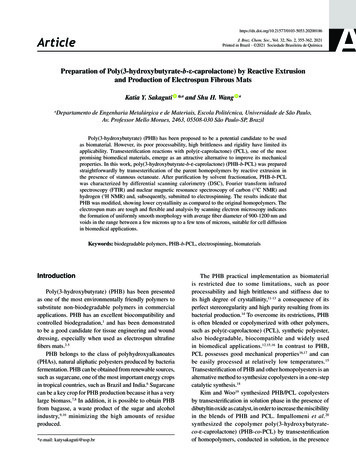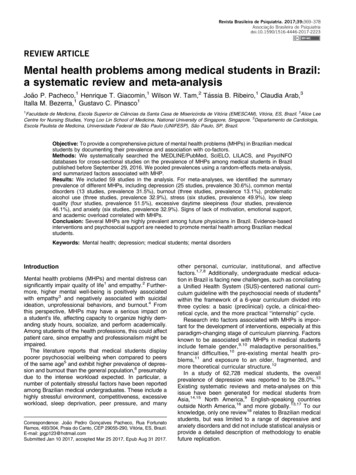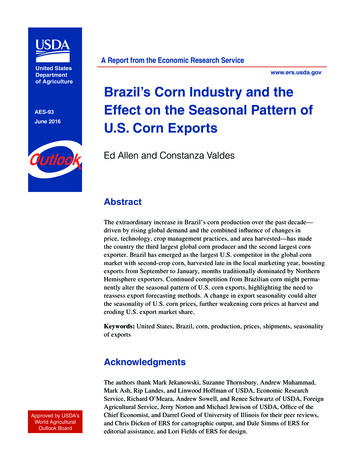
Transcription
cleJ. Braz. Chem. Soc., Vol. 32, No. 2, 355-362, 2021Printed in Brazil - 2021 Sociedade Brasileira de QuímicaPreparation of Poly(3-hydroxybutyrate-b-ε-caprolactone) by Reactive Extrusionand Production of Electrospun Fibrous MatsKatia Y. Sakaguti *,a and Shu H. WangaDepartamento de Engenharia Metalúrgica e de Materiais, Escola Politécnica, Universidade de São Paulo,Av. Professor Mello Moraes, 2463, 05508-030 São Paulo-SP, BrazilaPoly(3-hydroxybutyrate) (PHB) has been proposed to be a potential candidate to be usedas biomaterial. However, its poor processability, high brittleness and rigidity have limited itsapplicability. Transesterification reactions with poly(ε-caprolactone) (PCL), one of the mostpromising biomedical materials, emerge as an attractive alternative to improve its mechanicalproperties. In this work, poly(3-hydroxybutyrate-b-ε-caprolactone) (PHB-b-PCL) was preparedstraightforwardly by transesterification of the parent homopolymers by reactive extrusion inthe presence of stannous octanoate. After purification by solvent fractionation, PHB-b-PCLwas characterized by differential scanning calorimetry (DSC), Fourier transform infraredspectroscopy (FTIR) and nuclear magnetic resonance spectroscopy of carbon (13C NMR) andhydrogen (1H NMR) and, subsequently, submitted to electrospinning. The results indicate thatPHB was modified, showing lower crystallinity as compared to the original homopolymers. Theelectrospun mats are tough and flexible and analysis by scanning electron microscopy indicatesthe formation of uniformly smooth morphology with average fiber diameter of 900-1200 nm andvoids in the range between a few microns up to a few tens of microns, suitable for cell diffusionin biomedical applications.Keywords: biodegradable polymers, PHB-b-PCL, electrospinning, biomaterialsIntroductionPoly(3-hydroxybutyrate) (PHB) has been presentedas one of the most environmentally friendly polymers tosubstitute non-biodegradable polymers in commercialapplications. PHB has an excellent biocompatibility andcontrolled biodegradation,1 and has been demonstratedto be a good candidate for tissue engineering and wounddressing, especially when used as electrospun ultrafinefibers mats.2-5PHB belongs to the class of polyhydroxyalkanoates(PHAs), natural aliphatic polyesters produced by bacteriafermentation. PHB can be obtained from renewable sources,such as sugarcane, one of the most important energy cropsin tropical countries, such as Brazil and India.6 Sugarcanecan be a key crop for PHB production because it has a verylarge biomass.7,8 In addition, it is possible to obtain PHBfrom bagasse, a waste product of the sugar and alcoholindustry,9,10 minimizing the high amounts of residueproduced.*e-mail: katysakaguti@usp.brThe PHB practical implementation as biomaterialis restricted due to some limitations, such as poorprocessability and high brittleness and stiffness due toits high degree of crystallinity,11-13 a consequence of itsperfect stereoregularity and high purity resulting from itsbacterial production.14 To overcome its restrictions, PHBis often blended or copolymerized with other polymers,such as poly(ε-caprolactone) (PCL), synthetic polyester,also biodegradable, biocompatible and widely usedin biomedical applications.12,15,16 In contrast to PHB,PCL possesses good mechanical properties16,17 and canbe easily processed at relatively low temperatures. 15Transesterification of PHB and other homopolyesters is analternative method to synthesize copolyesters in a one-stepcatalytic synthesis.18Kim and Woo19 synthesized PHB/PCL copolyestersby transesterification in solution phase in the presence ofdibutyltin oxide as catalyst, in order to increase the miscibilityin the blends of PHB and PCL. Impallomeni et al. 20synthesized the copolymer poly(3-hydroxybutyrateco‑ε‑caprolactone) (PHB-co-PCL) by transesterificationof homopolymers, conducted in solution, in the presence
356Preparation of Poly(3-hydroxybutyrate-b-ε-caprolactone) by Reactive Extrusion and Productionof 4-toluenesulfonic acid. Chen et al.18 also synthesizedit by transesterification in liquid phase in the presence ofstannous octanoate.One efficient method to process biodegradablepolymers is by reactive extrusion, in which melt extrusionand chemical reaction occur simultaneously. Reactiveextrusion offers some advantages such as simplicity, costeffectiveness, control of the residence times, and it doesnot require solvents.21,22By copolymerizing PHB with PCL, a biodegradableand biocompatible material with enhanced mechanicalproperties and processability should be expected, increasingPHB applicability in tissue engineering. Electrospinningwas chosen in this study since it is an excellent and simplemethod to produce micron/submicron diameter fiber matsand membranes to be employed as scaffolds.13,23 So far,we have found no literature on PHB-co-PCL fibrous matsprepared by electrospinning.In this work, transesterification of PHB and PCLwas carried out by reactive extrusion processing in thepresence of stannous octanoate as catalyst in order tosynthesize ��b‑PCL). After purification by selective fractionation,the copolymer was characterized by differential scanningcalorimetry (DSC), Fourier transform infrared spectroscopy(FTIR), carbon-13 and hydrogen nuclear magneticresonance spectroscopy (13C and 1H NMR) and solubilitytests. Furthermore, this research explored the possibilityof producing mats comprised by PHB-b-PCL nanofibersthrough electrospinning, suitable for tissue engineeringapplications.J. Braz. Chem. Soc.Synthesis of PHB-b-PCL by reactive extrusion andpurificationInitially, a blend of PHB and PCL at molar ratio1:1 was prepared and dried under vacuum at 60 C for24 h. Under nitrogen atmosphere, 5 wt.% of Sn(Oct)2was added to the mixture. Scheme 1 shows the reactionmechanism. In a glove box, the components were mixedon a heating plate until a visually homogeneous moltenmixture was formed. The mixture was cooled and reducedto small pieces, then the material was gradually placedin the cooled hopper of a Laboratory Mixing Extruder(LME, Dynisco), for reactive extrusion processing. Theextrusion was carried out under nitrogen flow and theprocessing temperatures were set at 165 C (mixingchamber) and 165 C (extrusion die). To remove thestarting homopolymers and the catalyst, the extrudedmaterial was dissolved in dichloromethane and kept in anultrasonic bath at 38 C for 3 h, then filtered, for unreactedPHB separation, and the remaining filtrate precipitatedin methanol under magnetic stirring. The precipitatewas dried in a vacuum oven and further fractioned bydissolution in dichloromethane and precipitation inmethanol to remove the unreacted PCL that remainedsoluble in the solvent mixture. PHB-b-PCL was recoveredby filtration and a yellowish-white powder was obtainedafter drying in a vacuum oven (yield 32%, Mn 19,230and Mw 28,230 g mol 1).ExperimentalMaterialsBacterial poly(3-hydroxybutyrate) (PHB), obtainedby sugarcane, was supplied by PHB Industrial S.A.(Serrana, Brazil). Its weight-average molecular mass (Mw)determined by gel permeation chromatograph (GPC) was266,700 g mol 1. Poly(ε-caprolactone) (PCL), with a reportednumber-average molecular mass (Mn) of 80,000 g mol 1,and stannous octanoate [Sn(Oct)2] were purchased fromSigma-Aldrich (St. Louis, USA). Chloroform (CHCl3),methanol (MeOH) and dichloromethane (DCM) weresupplied by CAAL (São Paulo, Brazil). Tetrahydrofuran(THF) and 1,2-dichloroethane (DCE) were provided bySynth (Diadema, Brazil) and Merck (Darmstadt, Germany),respectively. All the reagents were used as received withoutany further treatment.Scheme 1. Synthesis reaction of PHB-b-PCL copolymer.Characterization of PHB-b-PCLSolubility tests were carried out by using differentsolvents (CHCl3, MeOH, DCM, THF and DCE). About1.0 mg of polymer was introduced into a test tubecontaining 1.0 mL of each solvent tested. The tubes wereimmersed in a bath thermostated at 40 C for 5 to 10 minand solubility was established by visual examination;the results were analyzed taking into account the Hansensolubility parameters of the components. Fourier transforminfrared (FTIR) spectra were obtained using the ThermoScientific Nicolet iS50 spectrophotometer in the attenuated
Vol. 32, No. 2, 2021Sakaguti and Wangtotal reflectance (ATR) mode with a ZnSe crystal. Thespectra were collected at room temperature with a scannumber of 16 and resolution of 4 cm 1. Nuclear magneticresonance spectroscopy (13C and 1H NMR) was carriedout on a Bruker AIII 500 MHz spectrometer. The NMRspectra were recorded at 23 C in chloroform-d (CDCl3)solution. Thermal analysis was carried out by using aNetzsch DSC 200F3 differential scanning calorimeter. Thesamples were cooled from room temperature to 120 C,and then maintained at 120 C for 5 min before heatingto 200 C at a rate of 10 C min 1. A second heating cyclewas followed, after cooling to 120 C, a final heating to200 C at a rate of 10 C min 1 was recorded.357at about 1380 cm 1 is related to the symmetrical waggingof CH3 group, the same observed in the PHB-b-PCLspectrum. In the PCL spectrum, a band of strong intensityobserved at 730 cm 1 is related to CH rocking vibrations,also observed in the copolymer. The PHB-b-PCL spectrumshows a strong presence of PCL in the copolymer structureindicated by the more intense bands related to the CH2 bondat 2900 cm 1 (stretching) and 1380 cm 1 (rocking). Theintense bands attributed to ester C–O bonds indicate themaintenance of the chemical structure. As expected, therewas no absorption in the region of 3500 cm 1 representingthe OH absorption region, whose absence indicates controlof the hydrolysis reaction, favoring the transesterificationreaction.Electrospinning of PHB-b-PCLPolymer solutions for electrospinning were preparedby dissolving a pre-established amount of PHB-b-PCLin chloroform in order to reach concentrations of 20 and25 wt.%. The electrospinning system is comprised by aninjection pump (Nikkiso PSK-01, Japan), equipped witha 20 mL plastic syringe connected to a stainless steelneedle (22 Gauge) without tip, a high voltage power source(Faíscas, Brazil) and a grounded collector covered with analuminum foil placed vertically. The voltage was appliedbetween the needle, ejection point, and the collector platecovered by aluminum foil and was set at 12 kV; the pumpingrate was varied from 1.0 to 1.2 mL h 1 and the workingdistance (distance between the tip of the needle and thecollector) was kept constant at 15 cm.Scanning electron microscopy of the electrospun matsThe electrospun mats were analyzed by scanningelectron microscopy (SEM, FEI Inspect F50 FEG) in orderto verify the formation of polymer fibers and to observe themorphology. Fiber diameters were statistically calculatedusing ImageJ software and DiameterJ plugin.24Figure 1. FTIR spectra (ATR) of PHB, PCL and PHB-b-PCL.Figure 2 shows the 13C NMR spectrum of PHB-b-PCLwith chemical shift assignments for each carbon. Thespectrum indicates the presence of both segments, PCLand PHB, with predominance of PCL, indicated by therelatively greater intensity of the corresponding carbonyl.This demonstrates that PCL segments were introduced intothe PHB chains by transesterification.Results and DiscussionThe FTIR technique is an efficient tool to obtaininformation on polymer copolymerization, such asinteractions detection and creation of new chemicalbonds. Figure 1 illustrates FTIR spectra of PHB, PCLand PHB‑b-PCL. The bands for PHB and PCL presentchemical similarity. Characteristic bands for PHB and PCLwere at 1715 cm 1 assigned to the stretching of C O bond,whereas a series of intense bands of axial deformation inthe region of 1100 to 1300 cm 1 correspond to C–O bondsof the ester group. In the PHB spectrum, the peak observedFigure 2. 13C NMR spectrum (125 MHz, CDCl3) of PHB-b-PCL.
358Preparation of Poly(3-hydroxybutyrate-b-ε-caprolactone) by Reactive Extrusion and ProductionThe mixed structure of the copolymer was confirmedby Figure 3, which shows the 1H NMR spectrum of thecopolymer with the corresponding assignments. Thesignals attributed to PHB segments were observed at d 1.27(doublet), 2.45-2.63 (multiplet) and 5.24‑5.28 (quartet).All the expected peaks of individual constituents couldbe found in the copolymer, suggesting block copolymerformation. There is a direct proportional correlationbetween the integrated area of the peaks and the numberof protons that generated these peaks, allowing thecomposition quantification of PHB and PCL content. Aratio of PHB to PCL of 1:2 was found, indicating that aconsiderable amount of PHB has not reacted during thetransesterification and was removed by the purificationprocedure.J. Braz. Chem. Soc.Figure 4. Solubility comparison between (a) PHB and (b) PHB-b-PCLdissolved in DCE.solubility parameters were calculated for the copolymerbased on the group contribution method applied on partialsolubility parameters for the proportions of PHB andPCL.25 Table 1 shows the copolymer Hansen solubilitycomponents and total solubility parameter closer to PCLvalues than that of PHB.Table 1. Hansen parameters for homopolymers and copolymer at 25 CPolymerdd / MPa1/2dp / MPa1/2dh / MPa1/2d / b-PCL16.56.28.4The solubility tests of PHB-b-PCL showed a mixedcharacter indicating the copolymer formation. PHB isinsoluble in all solvents tested except CHCl3, in which itwas soluble after heating. Conversely, PCL was solublein all solvents but MeOH, in which it was partiallysoluble. The product was soluble in CHCl3, DCM andDCE, partially soluble in THF and non-soluble in MeOH;therefore, comparatively more soluble in organic solventsthan PHB and less than PCL. Figure 4 shows the differentsolubility behavior of PHB and PHB-b-PCL dissolved inDCE.Interactions between the polymer and solvents wereanalyzed by comparing the solvent position with respectto the soluble region in the three-dimensional space forthe given polymer, the Hansen parameters, divided intothree-component to account for the dispersion, dd, thepolar interactions, dp, and hydrogen bonding, dh. Hansena19.5Obtained from Terada and Marchessault publication; obtainedfrom the Hansen publication. 27 dd: Hansen dispersion component;dp: Hansen polar interactions component; dh: Hansen hydrogen bondingcomponent; d: solubility parameter; PHB: poly(3-hydroxybutyrate);PCL: poly(ε‑caprolactone); PHB-b-PCL: re 3. 1H NMR spectrum (500 MHz, CDCl3) of PHB-b-PCL.a26 bTable 2 shows values for the Hansen parameters forthe solvents used. This explains why the copolymer ismore soluble in the solvents tested; however, it is notenough to make an accurate solubility evaluation, sincethe solubility parameter concept is applicable only toamorphous polymer. The crystalline shell of the PHBgranule could cause PHB to be insoluble in most solventsat room temperature.26DSC curves are shown in Figure 5. The DSC curve ofPHB-b-PCL showed crystallization at 44.9 C followed bymelting at 57.2 C, and then a further melting at 169.1 C,corresponding to the melting of crystals formed by PCL andPHB segments, respectively. The main thermal parametersobtained from DSC analysis are summarized in Table 3.The cold crystallization of PHB segments in thecopolymer occurred at a lower temperature than that
Vol. 32, No. 2, 2021359Sakaguti and WangTable 2. Hansen parameters for solvents at 25 CaSolventdd / MPa1/2dp / MPa1/2dh / MPa1/2d / MPa1/21,2-Dichloroethane (DCE)19.07.44.120.8Dichloromethane (DCM)18.26.36.120.2Chloroform (CHCl3)17.83.15.718.9Methanol (MeOH)15.112.322.329.6Tetrahydrofuran (THF)16.85.78.019.5Obtained from the Hansen publication.27 dd: Hansen dispersion component; dp: Hansen polar interactions component; dh: Hansen hydrogen bondingcomponent; d: solubility parameter.awhereis the melting enthalpy of the sample andis the melting enthalpy of the 100% crystalline polymer.Reference values forof 146 J g 1 21 was adopted for 1 28PHB, and 136 J gfor PCL. wi is the weight fraction ofthe corresponding block in the mixture. In the copolymer,the PCL and PHB fractions were estimated by 1H NMRspectrometry.The results indicate a decrease of the crystalline fractionof the copolymer as well as a reduction of the crystallinemelting temperatures for both PCL and PHB phases, aswould be expected for a copolymer.Two PHB-b-PCL solutions, 20 and 25 wt.%, weresuccessfully submitted to electrospinning with fiberformation as observed by SEM. Figure 6 shows themorphology of the fibrous structure obtained from the20 wt.% solution, whereby the main electrospinningconditions were set as feeding rate of 1 mL h 1, voltageof 12 kV and 15 cm of working distance. Some fibers areobserved to be bound and stuck to each other, generating anetwork of interconnected fibers, which presented a diameterrange from 450 to 1100 nm. These features are considered tobe a consequence of delayed evaporation of the solvent, whenthe ejected solution reaches the collector, however, within nosufficient time to evaporate, and the formed fiber jets piledup on each other before solidification. Instant solidificationin the collector is crucial during the electrospinning to ensurethe fibers cylindrical morphology and to preserve the porousstructure.29 The variation in the fiber diameter could beattributed to the jet instability during the process.Figure 7 presents the morphology and the fiber diameterdistributions in the mats prepared from the 25 wt.% solution.Figure 5. DSC curves of PHB, PCL and copolymer PHB-b-PCL.observed for PHB, due to the probable partial miscibilitywith PCL segments. There was also a reduction in themelting temperatures of crystallites in relation to thehomopolymers, confirming the effect of mutual disturbanceof the PCL and PHB segments, which make it difficult tobend the chains to form larger and more perfect crystallites.PHB and PCL homopolymers have high degree ofcrystallinity, 66.5 and 45.6%, respectively. The percentagesof crystallinity due to PHB and PCL segments in thecopolymer were 13.5 and 22.7%, respectively. Thedegrees of crystallinity (Xc) of PCL and PHB segments inhomopolymers and copolymer were determined from themelting enthalpy according to equation 1.(1)Table 3. Thermal parameters of homopolymers and copolymerPolymerΔHm / (J g 1)Tm / CXc / %Tg / CTc / CPCLPHBPCLPHBPCLPHBPHB2.755.3 170.4 96.9 66.5PCL 60.8NO60.4 61.5 45.6 59.0 / 1.144.957.2169.130.619.722.713.5PHB-b-PCLTg: glass transition temperature; Tc: crystallization temperature; Tm: melting temperature; ΔHm: melting enthalpy of the sample; Xc: degree of crystallinity;PHB: poly(3-hydroxybutyrate); PCL: poly(ε-caprolactone); PHB-b-PCL: poly(3-hydroxybutyrate-b‑ε‑caprolactone); NO: non-observed.
360Preparation of Poly(3-hydroxybutyrate-b-ε-caprolactone) by Reactive Extrusion and ProductionFigure 7a shows the results under the previous operatingcondition set for the 20 wt.% solution, while in Figure 7b,the same 25 wt.% solution was submitted to almost the sameJ. Braz. Chem. Soc.conditions, except that the feeding rate was incremented to1.2 mL h 1. However, both electrospun mats from the 25 wt.%solution presented similar uniform morphology, but a largerFigure 6. SEM images for 20 wt.% solution concentration under operating parameters 1 mL h 1, 12 kV, 15 cm with magnification of (a) 1,000 ; (b) 5,000 .Figure 7. SEM images and fiber diameter distribution histogram for 25 wt.% solution concentration under different operating parameters: (a) 1 mL h 1,12 kV, 15 cm and (b) 1.2 mL h 1, 12 kV, 15 cm.
Vol. 32, No. 2, 2021361Sakaguti and Wangvariation in fiber diameters was detected in the first one, theflow rate of which was lower, while the second presented asmaller quantity of droplets, greater dimensional stability andthe fiber diameter increased slightly. The fibers collected atthe flow rate of 1.0 mL h 1 have average diameter between900 and 1100 nm as compared to the 1100 and 1200 nmobserved at the higher flow rate of 1.2 mL h 1; additionally,the diameter distribution became narrower. Increasing thesolution concentration resulted in more homogeneous fiberswith few beads. When the concentration of the solution ishigh, more uniform fibers are formed because of the higherviscosity resistance.30The SEM images display significant empty spacesbetween the fibers, due to the random orientation of thedeposition of the material on the collector. Actually, themats are essentially formed by voids. For applications intissue engineering, these pores enhance the fluid absorptionand facilitate cell incorporation and perfusion. 31,32 Inaddition, due to the small fiber diameters, the specificsurface area is high, allowing better adsorption of proteinsand cell membrane receptors.13,332. Castellano, D.; Sanchis, A.; Blanes, M.; Perez Del Caz, M. D.;Ruiz-Sauri, A.; Piquer-Gil, M.; Pelacho, B.; Marco, B.; Garcia,N.; Ontoria-Oviedo, I.; Cambra, V.; Prosper, F.; Sepulveda, P.;J. Tissue Eng. Regener. Med. 2018, 12, e983.3. Jiang, Y.; Jia, G.; Zhicai, X.; Kyoung-Jin, S.; Insook, H.;Jung‑Chul, K.; Inn-Kyu, K.; Jian, S.; J. Tissue Eng. Regener.Med. 2015, 9, 1027.4. Sombatmankhong, K.; Sanchavanakit, N.; Pavasant, P.;Supaphol, P.; Polymer 2007, 48, 1419.5. Salvatore, L.; Carofiglio, V. E.; Stufano, P.; Bonfrate, V.; Calo,E.; Scarlino, S.; Nitti, P.; Centrone, D.; Cascione, M.; Leporatti,S.; Sannino, A.; Demitri, C.; Madaghiele, M.; J. HealthcareEng. 2018, 2018, 13.6. Moncada, J.; Matallana, L. G.; Cardona, C. A.; Ind. Eng. Chem.Res. 2013, 52, 4132.7. Petrasovits, L. A.; Purnell, M. P.; Nielsen, L. K.; Brumbley, S.M.; Plant Biotechnol. J. 2007, 5, 162.8. Petrasovits, L. A.; Zhao, L.; McQualter, R. B.; Snell, K. D.;Somleva, M. N.; Patterson, N. A.; Nielsen, L. K.; Brumbley,S. M.; Plant Biotechnol. J. 2012, 10, 569.9. Silva, L. F.; Taciro, M. K.; Ramos, M. E. M.; Carter, J. M.;Pradella, J. G. C.; Gomez, J. G. C.; J. Ind. Microbiol. Biotechnol.Conclusions2004, 31, 245.10. Yu, J.; Stahl, H.; Bioresour. Technol. 2008, 99, 8042.In this work, PHB-b-PCL was successfully synthesizedby transesterification of PHB, as hard segments, and PCL,as soft segments, using reactive extrusion. The PHB-b-PCLpresented predominance of PCL segments and reducedcrystallinity, facilitating its application in biomaterials.Smooth and uniform fibers with average diameters between900 and 1200 nm were obtained by electrospinning. Moreuniform fibers were acquired when more concentratedsolution was electrospun. In addition to the solutionconcentration, other parameters, such as applied voltageand flow rate, also affected the formation and size of thefibers. PHB-b-PCL sub micrometric fiber membranes hereprepared are potential candidates for producing scaffolds forcell growth, indicating a promising biodegradable material tobe made available in the future in the field of biomedicine.11. Alicata, R.; Barbuzzi, T.; Giuffrida, M.; Ballistreri, A.; RapidAcknowledgments18. Chen, C.; Fei, B.; Peng, S.; Wu, H.; Zhuang, Y.; Chen, X.;Commun. Mass Spectrom. 2006, 20, 568.12. Marega, C.; Marigo, A.; J. Appl. Polym. Sci. 2015, 132,42265.13. Karahaliloğlu, Z.; Demirbilek, M.; Şam, M.; Erol-Demirbilek,M.; Sağlam, N.; Denkbaş, E. B.; J. Appl. Polym. Sci. 2013, 128,1904.14. Ublekov, F.; Budurova, D.; Staneva, M.; Natova, M.; Penchev,H.; Mater. Lett. 2018, 218, 353.15. Ghavimi, S. A. A.; Ebrahimzadeh, M. H.; Solati-Hashjin, M.;Osman, N. A. A.; J. Biomed. Mater. Res., Part A 2015, 103,2482.16. Woodruff, M. A.; Hutmacher, D. W.; Prog. Polym. Sci. 2010,35, 1217.17. Lim, J. S.; Ki, C. S.; Kim, J. W.; Lee, K. G.; Kang, S. W.; Kweon,H. Y.; Park, Y. H.; Biopolymers 2012, 97, 265.Dong, L.; Feng, Z.; J. Polym. Sci., Part B: Polym. Phys. 2002,This study was supported by the Brazilian Coordinationfor the Improvement of Higher Education Personnel(CAPES, finance code 001) and by the Brazilian Councilfor Scientific and Technological Development (CNPq).40, 1893.19. Kim, B. O.; Woo, S. I.; Polym. Bull. 1998, 41, 707.20. Impallomeni, G.; Giuffrida, M.; Barbuzzi, T.; Musumarra, G.;Ballistreri, A.; Biomacromolecules 2002, 3, 835.21. Garcia-Garcia, D.; Rayón, E.; Carbonell-Verdu, A.; Lopez-ReferencesMartinez, J.; Balart, R.; Eur. Polym. J. 2017, 86, 41.22. Jean-Marie, R.; Ramani, N.; Philippe, D.; Macromol. Mater.1. Cao, K.; Liu, Y.; Olkhov, A. A.; Siracusa, V.; Iordanskii, A. L.;Drug Delivery Transl. Res. 2018, 8, 291.Eng. 2008, 293, 447.23. Kampeerapappun, P.; J. Appl. Polym. Sci. 2016, 133, 43273.
362Preparation of Poly(3-hydroxybutyrate-b-ε-caprolactone) by Reactive Extrusion and Production24. Hotaling, N. A.; Bharti, K.; Kriel, H.; Simon Jr., C. G.;Biomaterials 2015, 61, 327.25. Schenderlein, S.; Lück, M.; Müller, B. W.; Int. J. Pharm. 2004,J. Braz. Chem. Soc.29. Fang, J.; Wang, H.; Niu, H.; Lin, T.; Wang, X.; J. Appl. Polym.Sci. 2010, 118, 2553.30. Bhardwaj, N.; Kundu, S. C.; Biotechnol. Adv. 2010, 28, 325.31. Aghdam, R. M.; Najarian, S.; Shakhesi, S.; Khanlari, S.;286, 19.26. Terada, M.; Marchessault, R. H.; Int. J. Biol. Macromol. 1999,Shaabani, K.; Sharifi, S.; J. Appl. Polym. Sci. 2012, 124, 123.32. Norouzi, M.; Boroujeni, S. M.; Omidvarkordshouli, N.;25, 207.27. Hansen, C. M.; Hansen Solubility Parameters: A User’sHandbook, 2nd ed.; CRC Press: Boca Raton, USA, 2007.28. Wu, L.; Chen, S.; Li, Z.; Xu, K.; Chen, G.-Q.; Polym. Int. 2008,Soleimani, M.; Adv. Healthcare Mater. 2015, 4, 1114.33. Agarwal, S.; Wendorff, J. H.; Greiner, A.; Adv. Mater. 2009, 21,3343.57, 939.Submitted: April 21, 2020Published online: September 11, 2020This is an open-access article distributed under the terms of the Creative Commons Attribution License.
About 1.0 mg of polymer was introduced into a test tube containing 1.0 mL of each solvent tested. The tubes were immersed in a bath thermostated at 40 C for 5 to 10 min and solubility was established by visual examination; the results were analyzed taking into account the Hansen solubility parameters of the components.











